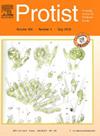Soil ciliates' response to glyphosate exposure: A microcosm experiment
IF 2.1
3区 生物学
Q4 MICROBIOLOGY
引用次数: 0
Abstract
The widespread use of glyphosate, a broad-spectrum herbicide, in agriculture raises concerns about its impact on non-target organisms and ecosystem functions. Research on glyphosate's effect on soil microorganisms has been inconsistent due to varying methodologies and focuses. To address this, a controlled microcosm study was conducted to investigate glyphosate's impact on soil ciliates, an essential component of soil microbial communities. This study is among the first to examine glyphosate impact on ciliates. The experiment used agricultural soil with glyphosate applied at standard and elevated rates. Ciliate abundance and species richness were monitored in the microcosms at 1-, 7-, and 15-days post-application. Soil ciliates showed remarkable tolerance to glyphosate at standard application rates, with a notable increase in abundance after 15 days, primarily driven by one species' proliferation. This study demonstrates the resilience of ciliate communities to standard glyphosate rates, suggesting their crucial role in maintaining soil functionality in the presence of the herbicide. However, it also highlights potential ecological risks at higher glyphosate concentrations, as evidenced by the loss of ciliate species at the highest rates tested. These findings contribute to our understanding of glyphosate's impact on soil ecosystems and highlights the importance of further research in this area.
土壤纤毛虫对草甘膦暴露的反应:一个微观实验
草甘膦是一种广谱除草剂,在农业中的广泛使用引起了人们对其对非目标生物和生态系统功能的影响的担忧。关于草甘膦对土壤微生物影响的研究,由于方法和重点的不同,一直不一致。为了解决这个问题,进行了一项对照微观研究,以研究草甘膦对土壤纤毛虫的影响,纤毛虫是土壤微生物群落的重要组成部分。这项研究是首批研究草甘膦对纤毛虫影响的研究之一。试验使用农用土壤,草甘膦按标准和高施用量施用。在施用后1、7和15 d监测微环境中纤毛虫的丰度和物种丰富度。在标准施用量下,土壤纤毛虫对草甘膦表现出显著的耐受性,15 d后丰度显著增加,主要是由一个物种的增殖驱动。这项研究证明了纤毛虫群落对标准草甘膦浓度的恢复能力,表明它们在除草剂存在下维持土壤功能的关键作用。然而,它也强调了草甘膦浓度较高时的潜在生态风险,所测试的最高比率的纤毛虫物种损失证明了这一点。这些发现有助于我们了解草甘膦对土壤生态系统的影响,并强调了在这一领域进一步研究的重要性。
本文章由计算机程序翻译,如有差异,请以英文原文为准。
求助全文
约1分钟内获得全文
求助全文
来源期刊

Protist
生物-微生物学
CiteScore
3.60
自引率
4.00%
发文量
43
审稿时长
18.7 weeks
期刊介绍:
Protist is the international forum for reporting substantial and novel findings in any area of research on protists. The criteria for acceptance of manuscripts are scientific excellence, significance, and interest for a broad readership. Suitable subject areas include: molecular, cell and developmental biology, biochemistry, systematics and phylogeny, and ecology of protists. Both autotrophic and heterotrophic protists as well as parasites are covered. The journal publishes original papers, short historical perspectives and includes a news and views section.
 求助内容:
求助内容: 应助结果提醒方式:
应助结果提醒方式:


